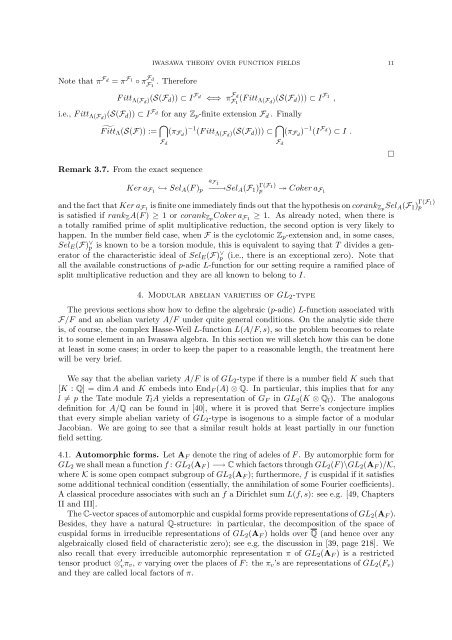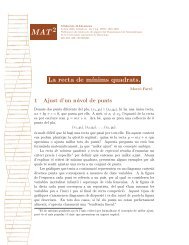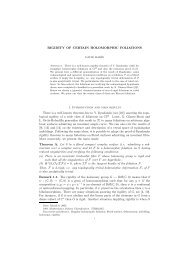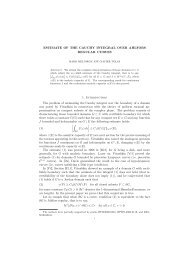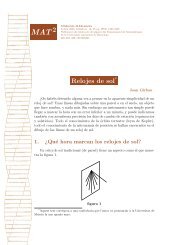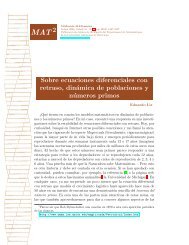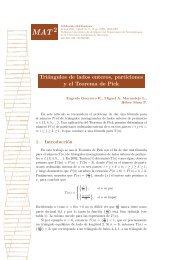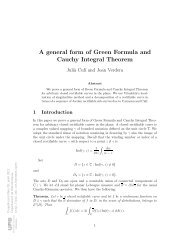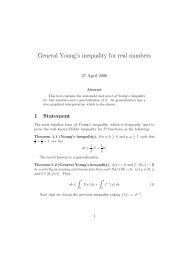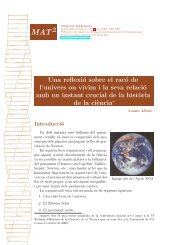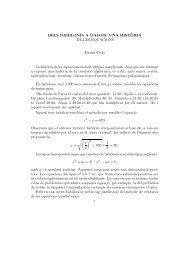ASPECTS OF IWASAWA THEORY OVER FUNCTION FIELDS 1 ...
ASPECTS OF IWASAWA THEORY OVER FUNCTION FIELDS 1 ...
ASPECTS OF IWASAWA THEORY OVER FUNCTION FIELDS 1 ...
Create successful ePaper yourself
Turn your PDF publications into a flip-book with our unique Google optimized e-Paper software.
Note that π F d= π F 1◦ π F dF 1. Therefore<strong>IWASAWA</strong> <strong>THEORY</strong> <strong>OVER</strong> <strong>FUNCTION</strong> <strong>FIELDS</strong> 11F itt Λ(Fd )(S(F d )) ⊂ I F d⇐⇒ π F dF 1(F itt Λ(Fd )(S(F d ))) ⊂ I F 1,i.e., F itt Λ(Fd )(S(F d )) ⊂ I F dfor any Z p -finite extension F d . Finally˜F itt Λ (S(F)) := ⋂ F d(π Fd ) −1 (F itt Λ(Fd )(S(F d ))) ⊂ ⋂ F d(π Fd ) −1 (I F d) ⊂ I .Remark 3.7. From the exact sequenceKer a F1 ↩→ Sel A (F ) pa F1−−→Sel A (F 1 ) Γ(F 1)p ↠ Coker a F1and the fact that Ker a F1 is finite one immediately finds out that the hypothesis on corank Zp Sel A (F 1 ) Γ(F 1)pis satisfied if rank Z A(F ) ≥ 1 or corank Zp Coker a F1 ≥ 1. As already noted, when there isa totally ramified prime of split multiplicative reduction, the second option is very likely tohappen. In the number field case, when F is the cyclotomic Z p -extension and, in some cases,Sel E (F) ∨ p is known to be a torsion module, this is equivalent to saying that T divides a generatorof the characteristic ideal of Sel E (F) ∨ p (i.e., there is an exceptional zero). Note thatall the available constructions of p-adic L-function for our setting require a ramified place ofsplit multiplicative reduction and they are all known to belong to I.4. Modular abelian varieties of GL 2 -typeThe previous sections show how to define the algebraic (p-adic) L-function associated withF/F and an abelian variety A/F under quite general conditions. On the analytic side thereis, of course, the complex Hasse-Weil L-function L(A/F, s), so the problem becomes to relateit to some element in an Iwasawa algebra. In this section we will sketch how this can be doneat least in some cases; in order to keep the paper to a reasonable length, the treatment herewill be very brief.We say that the abelian variety A/F is of GL 2 -type if there is a number field K such that[K : Q] = dim A and K embeds into End F (A) ⊗ Q. In particular, this implies that for anyl ≠ p the Tate module T l A yields a representation of G F in GL 2 (K ⊗ Q l ). The analogousdefinition for A/Q can be found in [40], where it is proved that Serre’s conjecture impliesthat every simple abelian variety of GL 2 -type is isogenous to a simple factor of a modularJacobian. We are going to see that a similar result holds at least partially in our functionfield setting.4.1. Automorphic forms. Let A F denote the ring of adeles of F . By automorphic form forGL 2 we shall mean a function f : GL 2 (A F ) −→ C which factors through GL 2 (F )\GL 2 (A F )/K,where K is some open compact subgroup of GL 2 (A F ); furthermore, f is cuspidal if it satisfiessome additional technical condition (essentially, the annihilation of some Fourier coefficients).A classical procedure associates with such an f a Dirichlet sum L(f, s): see e.g. [49, ChaptersII and III].The C-vector spaces of automorphic and cuspidal forms provide representations of GL 2 (A F ).Besides, they have a natural Q-structure: in particular, the decomposition of the space ofcuspidal forms in irreducible representations of GL 2 (A F ) holds over Q (and hence over anyalgebraically closed field of characteristic zero); see e.g. the discussion in [39, page 218]. Wealso recall that every irreducible automorphic representation π of GL 2 (A F ) is a restrictedtensor product ⊗ ′ vπ v , v varying over the places of F : the π v ’s are representations of GL 2 (F v )and they are called local factors of π.□


